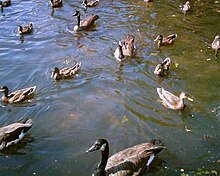Water bird

The term water bird, waterbird or aquatic bird (not to be confused with wading birds) is used to refer to birds that live on or around water. Some definitions apply the term especially to birds in freshwater habitats, though others make no distinction from birds that inhabit marine environments. In addition, some water birds are more terrestrial or aquatic than others, and their adaptations will vary depending on their environment. These adaptations include webbed feet, bills and legs adapted to feed in water, and the ability to dive from the surface or the air to catch prey in water.
The term aquatic bird is sometimes also used in this context. A related term that has a narrower meaning is waterfowl. Some birds of prey, such as ospreys and sea eagles, take prey from water but are not considered water birds. The term waterbird is also used in the context of conservation to refer to any birds that inhabit or depend on bodies of water or wetland areas. Examples of this use include the Agreement on the Conservation of African-Eurasian Migratory Waterbirds (AEWA) and the Wallnau Waterbird Reserve.
Some examples of water birds are:
- Seabirds (marine birds, such as penguins and gulls)
- Shorebirds (waders, order Charadriiformes)
- Anseriformes (ducks, geese, swans, magpie geese, screamers)
- Grebes (order Podicipediformes)
- Loons (order Gaviiformes)
- Ciconiiformes (storks, herons, egrets, ibises, spoonbills and others)
- Pelecaniformes (pelicans and others)
- Flamingos (order Phoenicopteriformes)
- Some members of the order Gruiformes (including cranes and rails, crakes, coots and moorhens)
- Kingfishers (mainly the water kingfishers, sometimes the river kingfishers, and rarely the tree kingfishers)
- One family of passerines, the dippers

